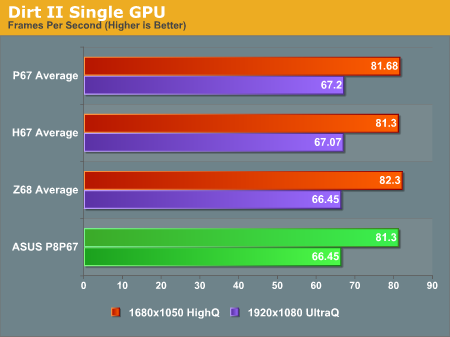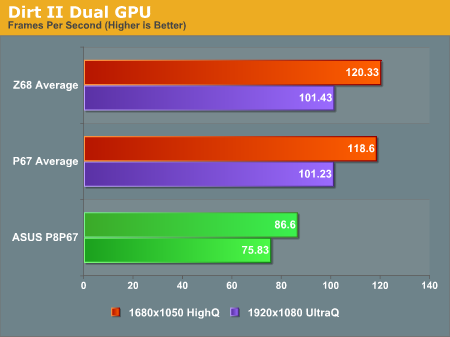ASUS P8P67 Review
by Brendan van Varik on September 8, 2011 10:45 AM EST- Posted in
- Asus
- Motherboards
- P67
Dirt 2
Dirt 2 came to the PC in December 2009, developed by Codemasters with the EGO Engine. Resulting in favorable reviews, we use Dirt 2’s inbuilt benchmark under DirectX 11 to test the hardware. We test two different resolutions at two different quality settings using a discrete GPU, and an appropriate integrated GPU setting.


At 1680x1050, the results are all fairly similar from what we have tested in the past. At 1920x1080, the results portray a different story. When you use a single GPU, the results are all fairly similar but when you use a dual GPU configuration, the x4 secondary PCIe lane becomes apparent. Whilst all of the other motherboards manage between 100 and 105 frames per second, the P8P67 only manages to get just under 76. Due to the testing methodology being exactly the same, the only explanation is that there is not enough bandwidth.
Metro 2033
Metro 2033 is a challenging DX11 benchmark that challenges every system that tries to run it at any high-end settings. Developed by 4A Games and released in March 2010, we use the inbuilt DirectX 11 Frontline benchmark to test the hardware.


The single GPU results are remarkably similar to all of the other results which we have on record. There is one thing that did differ to the DiRT2 testing though - In Metro 2033, the dual GPU scaling is almost as good as with any other motherboard in 1920x1080.
Conclusions
Overall, when you look at the results as a whole, they are neither good nor bad for a single GPU. However, with the second PCIe lane being limited to 4x, the results are quite a bit slower in some of our tests when compared to a board which utilizes x8/x8 rather than x16/x4. This may be enough to deter people away from this motherboard but in order to bring a board to the market with a budget price in mind; you have to cut down on a few features here and there.










52 Comments
View All Comments
DanNeely - Thursday, September 8, 2011 - link
How are raid 5/10 supposed to work on the two gray SATA6GB ports? You need 3/4 drives to implement those levels.IanCutress - Thursday, September 8, 2011 - link
The ASUS website suggests you can build an array across all the PCH SATA3/6 ports, just not the controller ones.Ian
JonnyDough - Thursday, September 8, 2011 - link
Well that seems silly if your array only runs at SATA II speeds...LtGoonRush - Thursday, September 8, 2011 - link
How many people are going to be building RAID arrays out of more than two SATA600 SSDs? No HDD can even approach SATA300 speeds so it's not really an issue .etamin - Friday, September 9, 2011 - link
HDD burst speeds (reads) can surpass 3gbps. I just saw an article showing the Hitachi DeskStar 3TB 7K3000 can burst to about 5gbps...and just because you don't use more than two drives in a RAID array doesn't mean other people don't.WillR - Saturday, September 10, 2011 - link
He didn't say other people don't. He implied only few do. This is a $150 board, not an enthusiast model. Anyone willing to shell out a couple grand on their SSDs alone should look elsewhere for a board, or more likely an add-on PCI-e x8 card with REAL RAID support, to better suit their needs.DanNeely - Thursday, September 8, 2011 - link
Ok, that would make sense. The review could be clearer on the point though.Taft12 - Thursday, September 8, 2011 - link
mdadmDanNeely - Thursday, September 8, 2011 - link
Soft-raid is completely chipset irrelevant.hurrakan - Thursday, September 8, 2011 - link
Thanks for the review.But I wish it was a review of the P8P67 Pro... specifically the new 3.1 revision with USB 3 controllers by Asmedia (instead of NEC).
I prefer single-card graphics anyway - my GTX580 is enough for now :) Consoles have been holding back PC gaming for too long - PC games aren't very demanding on hardware these days :(